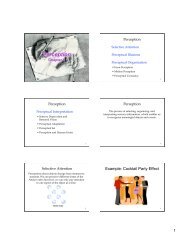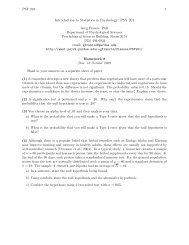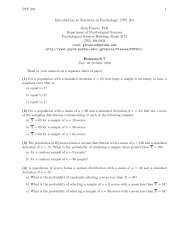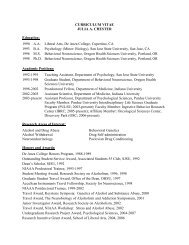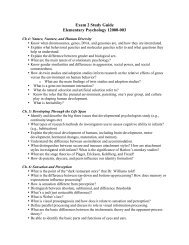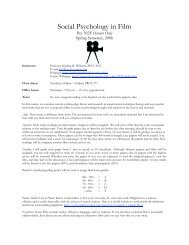Maxims or Myths of Beauty? A Meta-Analytic and Theoretical Review
Maxims or Myths of Beauty? A Meta-Analytic and Theoretical Review
Maxims or Myths of Beauty? A Meta-Analytic and Theoretical Review
You also want an ePaper? Increase the reach of your titles
YUMPU automatically turns print PDFs into web optimized ePapers that Google loves.
404 LANGLOIS ET AL.<br />
found in other meta-analyses <strong>of</strong> stranger attribution research<br />
(Eagly et al., 1991; Feingold, 1992b).<br />
To evaluate developmental differences in attractiveness effects,<br />
we merged the overall categ<strong>or</strong>y files f<strong>or</strong> adults <strong>and</strong> children f<strong>or</strong><br />
reliability <strong>of</strong> attractiveness ratings, judgment, treatment, <strong>and</strong> be-<br />
havi<strong>or</strong>/traits. We then conducted multiple regression analyses as<br />
previously described (see Table 10). No age differences were<br />
obtained. Because most <strong>of</strong> the studies available f<strong>or</strong> review in this<br />
meta-analysis examined children ages 6 <strong>and</strong> older, the lack <strong>of</strong><br />
developmental differences could be explained by the omission <strong>of</strong><br />
very young children in the rep<strong>or</strong>ted literature. However, at this<br />
point, we conclude that attractiveness is as imp<strong>or</strong>tant, if not m<strong>or</strong>e<br />
so, f<strong>or</strong> children as f<strong>or</strong> aduks.<br />
General Discussion<br />
The effects <strong>of</strong> facial attractiveness are robust <strong>and</strong> p<strong>and</strong>emic,<br />
extending beyond initial impressions <strong>of</strong> strangers to actual inter-<br />
actions with those whom people know <strong>and</strong> observe. Contrary to<br />
conventional wisdom, there is strong agreement both within <strong>and</strong><br />
across cultures about who is <strong>and</strong> who is not attractive. Further-<br />
m<strong>or</strong>e, attractiveness is a significant advantage f<strong>or</strong> both children<br />
<strong>and</strong> adults in almost every domain <strong>of</strong> judgment, treatment, <strong>and</strong><br />
behavi<strong>or</strong> we examined. The magnitude <strong>of</strong> attractiveness effects is<br />
roughly the same as <strong>or</strong> larger than that <strong>of</strong> other imp<strong>or</strong>tant variables<br />
in the social sciences (Eagly, 1995). In most cases, the benefits <strong>of</strong><br />
attractiveness are large enough to be "visible to the naked eye"<br />
(Cohen, 1988) <strong>and</strong> are <strong>of</strong> considerable practical significance (Lip-<br />
sey & Wilson, 1993; Rosenthal, 1991, 1995). These meta-analyses<br />
starkly illuminate the fundamental contradiction between empiri-<br />
cal research <strong>and</strong> maxims about beauty. On the basis <strong>of</strong> our results,<br />
we conclude that the maxims we examined are myths, not reality:<br />
<strong>Beauty</strong> is m<strong>or</strong>e than just in the eye <strong>of</strong> the beholder; people do<br />
judge <strong>and</strong> treat others with whom they interact based on attrac-<br />
tiveness; <strong>and</strong>, perhaps most surprisingly, beauty is m<strong>or</strong>e than just<br />
skin-deep.<br />
Table 10<br />
Moderat<strong>or</strong> Variable Analyses f<strong>or</strong> Age Comparisons<br />
The<strong>or</strong>etical Mechanisms<br />
One <strong>of</strong> our goals was to illuminate mechanisms explaining how<br />
<strong>and</strong> why attractiveness influences judgment, treatment, <strong>and</strong> behav-<br />
i<strong>or</strong>. Several predictions about how attractiveness functions in these<br />
different domains were derived from socialization/social expect-<br />
ancy the<strong>or</strong>ies <strong>and</strong> from fitness-related evolutionary the<strong>or</strong>ies.<br />
Socialization <strong>and</strong> Social Expectancy The<strong>or</strong>ies<br />
Recall the assumptions underlying socialization <strong>and</strong> social ex-<br />
pectancy the<strong>or</strong>ies set f<strong>or</strong>th in the introduction. First, f<strong>or</strong> appearance<br />
to have any consistent impact on differential judgment <strong>or</strong> treat-<br />
ment, individuals must agree about who is <strong>and</strong> is not attractive. As<br />
we have seen, there is remarkable similarity in attractiveness<br />
ratings. Indeed, we found substantial agreement about who is <strong>and</strong><br />
is not attractive both within <strong>and</strong> across cultures. The finding <strong>of</strong><br />
high cross-cultural agreement in attractiveness judgments, how-<br />
ever, is not consistent with socialization <strong>and</strong> social expectancy<br />
the<strong>or</strong>ies because they emphasize cultural differences in percep-<br />
tions <strong>of</strong> attractiveness.<br />
Second, attractiveness must consistently elicit differential ex-<br />
pectations from others. Acc<strong>or</strong>ding to the the<strong>or</strong>ies, these expecta-<br />
tions are acted on by perceivers in the f<strong>or</strong>m <strong>of</strong> differential judg-<br />
ment <strong>and</strong> treatment toward attractive <strong>and</strong> unattractive targets. Our<br />
results extend the findings from the stranger-attribution literature<br />
to the inf<strong>or</strong>med judgments <strong>of</strong> others based not on photographs<br />
alone but on actual interactions. Perceivers judged attractive tar-<br />
gets m<strong>or</strong>e fav<strong>or</strong>ably than unattractive targets even when they knew<br />
them. Furtherm<strong>or</strong>e, these results show that perceivers treated even<br />
familiar children <strong>and</strong> adults differently based on attractiveness<br />
(see, e.g., Langlois et al., 1995).<br />
Attractive <strong>and</strong> unattractive targets should then develop differ-<br />
ential behavi<strong>or</strong>s <strong>and</strong> traits as a result <strong>of</strong> differential evaluation <strong>and</strong><br />
treatment. Behavi<strong>or</strong>al <strong>and</strong> trait differences clearly exist between<br />
attractive <strong>and</strong> unattractive people, supp<strong>or</strong>ting this aspect <strong>of</strong> the<br />
Differential judgment Differential treatment Behavi<strong>or</strong>/trait differences<br />
Predict<strong>or</strong> unst<strong>and</strong>ardized beta unst<strong>and</strong>ardized beta unst<strong>and</strong>ardized beta<br />
Rater type -.088 .177 -.037<br />
Target gender -.008 .006 -.032<br />
Treater gender .032<br />
Physical attractiveness measure .193 -.235 -.372 ***a<br />
Physical attractiveness range -.058<br />
Familiarity - .040 - .071<br />
Year <strong>of</strong> publication .019 .016 .003<br />
Age -.012 .002 -.005<br />
Sample size .00006 .00001 -.0001<br />
Intercept - 35.77 - 31.85 - 5.62<br />
Overall R 2 .335 .278 .151<br />
QR 73.36 57.91 231.20"**<br />
QE 145.55"** 150.32"** 1,303.32"**<br />
Note. Unst<strong>and</strong>ardized beta weights are entered into the meta-analysis (Knight, Fabes, & Higgins, 1996). QR =<br />
overall regression effect; QE = test Of model specification.<br />
a Measures <strong>of</strong> general > facial attractiveness.<br />
***p < .001.





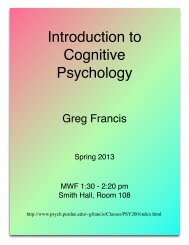

![Exam 4 Study Guide[1]](https://img.yumpu.com/45196739/1/190x245/exam-4-study-guide1.jpg?quality=85)
